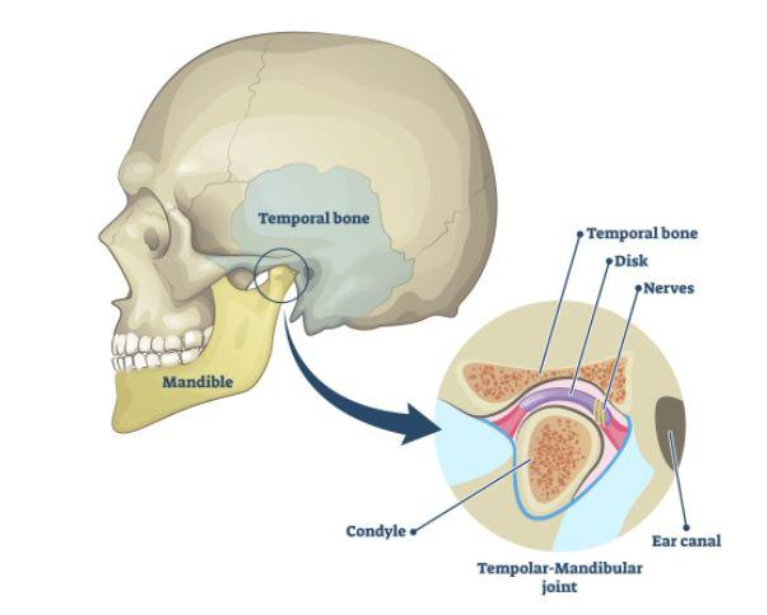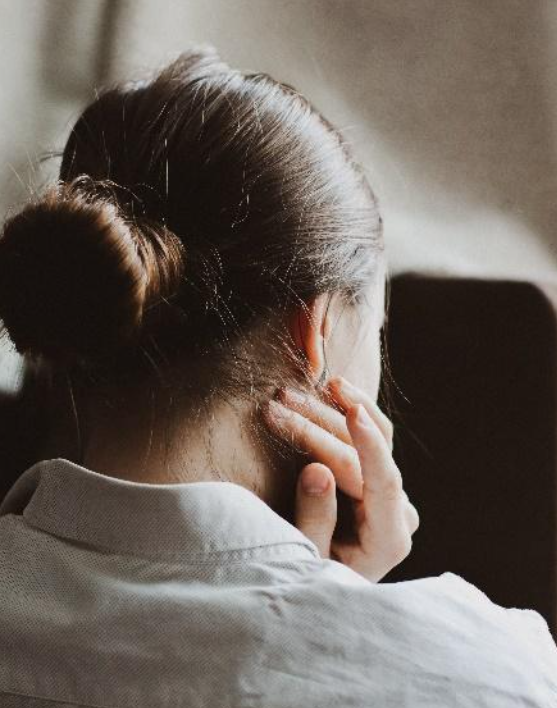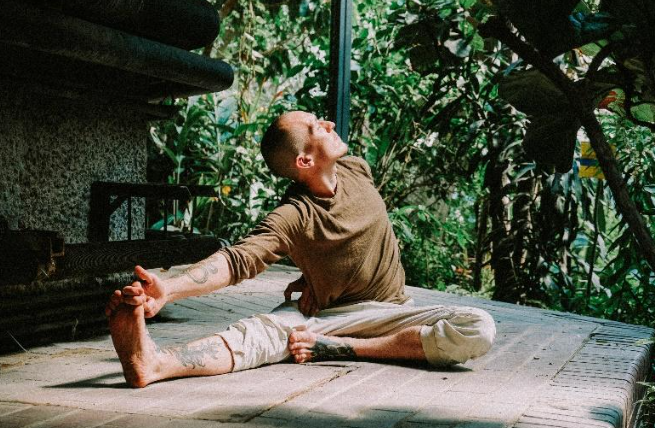What is TMJ?
The acronym TMJ stands for temporomandibular joint which is a joint located in front of the ears on either side of the face (see diagram below). The TMJ supports oral functions such as eating and speaking by connecting the lower jawbone to the skull.1

What is TMJ Pain?
TMJ pain is technically called TMD or temporomandibular joint disorder. TMD describes any dysfunction of the TMJ.2 However, TMJ and TMD are often used interchangeably in conversation.1
- Causes of TMJ/TMD2
- Acute injury directly to the jaw or TMJ
- Malocclusion or bite disharmony
- Orthodontic treatment (e.g., braces or headgear)
- Damage to the joint disk or cartilage
- Stress or anxiety that causes clenching/grinding (bruxism)
- Arthritis in the TMJ

- Symptoms of TMJ/TMD3
- TMJ pain often fluctuates (i.e., comes and goes), but some individuals may experience more chronic symptoms
- Pain in the face, jaw joint, neck, and shoulders
- Pain when eating, talking, or opening the mouth widely
- Limited range of movement (i.e., difficulty opening the mouth widely or jaws that get “locked” open/closed)
- Clicking and popping sounds in the TMJ area
- Difficulty chewing and/or poor digestion
- Tinnitus (ringing in ears)
- Tooth pain
- Gum recession
- TMJ pain often fluctuates (i.e., comes and goes), but some individuals may experience more chronic symptoms
Do I have TMJ or TMD?
Invasive Treatments for TMJ Pain
While many healthcare providers recommend beginning with conservative options for treatment, the following treatments may also be suggested1:
- Arthrocentesis Surgery
- Arthroscopy Surgery
- Open-Joint Surgery
Complementary and Alternative (CAM) Therapies for TMJ Pain
- Benefits to Seeking CAM Therapies
- While these therapies may be in addition to bite rejuvenating dental care, some individuals may find relief solely from CAM therapies.
- By pursuing alternatives to surgery and medication, it allows individuals to avoid potentially negative long-term side effects.
- Studies show that 75% of people with TMJ pain find relief by following a comprehensive treatment plan that incorporates multiple CAM therapies.2
- Types of CAM Therapies
- Craniosacral Therapy – This healing technique aims to support the central nervous system by utilizing a gentle hands-on approach. Tension is released via light membrane and fluid movement thus stimulating a sense of well-being while also invigorating immunity and reducing pain.5 Patients with TMJ pain often relay that this therapy helps them relieve tension in their jaw.
- Acupuncture – Acupuncture is a form of Chinese medicine that is frequently used to treat pain, decrease stress, and increase well-being. It requires very thin needles to be inserted into the skin at strategic points on one’s body.6 Studies show that acupuncture can often provide long-term relief for TMJ-related pain.2,7-9
- Chiropractic Medicine – Chiropractic treatment aims to reharmonize the relationship between one’s skeleton, muscles, and nerves. This is achieved through manual therapy and spinal manipulation. Individuals with chronic TMJ pain may find this to be a supportive adjunct therapy for symptom relief.10
- Massage Therapy – Massage therapy aids in stress reduction, muscle tension release, and relaxation by manipulating soft tissues (e.g., muscle, connective tissue, tendons, ligaments, and skin) with a variety of pressure and movement. When experiencing TMD, massage therapy can often provide a supportive release of tension and discomfort.11
- Relaxation Therapy – While many modalities of relaxation techniques exist, the shared purpose is to alleviate stress and improve quality of life. Relaxation techniques can provide a multitude of benefits such as: slowing heart rate, improved digestion, increasing blood flow, reducing muscle tension and chronic pain, and improving sleep. Deep breathing, meditation, yoga, biofeedback, aromatherapy, and hydrotherapy are examples of commonly practiced relaxation techniques.12 Patients managing chronic TMJ discomfort often report an improved state of well-being when relaxation therapy is incorporated in their lifestyle.
- Prolotherapy – Prolotherapy refers to the repeated injection of an irritant solution (typically a sugar solution) that stimulates growth within the connective tissue of the joint. Following this care, most patients experience a decrease in pain. This modality has been shown to reduce TMJ pain, increase range of jaw motion, and improve joint stability.13
- Laser Therapy – Low level laser therapy (LLLT) is a type of medicine that directs lasers on specific surfaces of the body in order to alleviate pain and stimulate cell function.14 Research indicates that LLLT is an effective & non-invasive means for reducing TMD.15
- Homeopathy – Homeopathy is a medical system that utilizes minuscule amounts of natural substances to stimulate a healing process. It is based on the principle that “likes cure likes”, meaning that “a disease can be cured by a substance that produces similar symptoms in healthy people.”16 Homeopathic remedies have been shown to offer symptomatic relief for patients with TMD.17
- Botox Injections – Botox is an injected form of botulinum toxin which blocks specific chemical signals from nerves.18 While botox injections are most commonly used for cosmetic purposes, they also offer promising relief from other ailments. As it relates to TMD, many patients receive pain relief when it is injected in the TMJ joint.19

Experiencing TMJ Pain?
If you are currently experiencing TMJ related pain, we suggest speaking with your holistic dentist. While more direct care may be suggested for addressing TMD, your practitioner may also recommend CAM therapies as part of your comprehensive path to wellbeing.
If you’d like to learn more about how Dr. Sharon Dickerson DDS approaches TMD and integrates CAM therapies, please feel welcome to contact our office at 720.842.7002.
In addition to holistic techniques, many patients are finding relief through modern solutions like laser dentistry. At Sharon Dickerson DDS, we proudly offer advanced Denver laser dentistry options to reduce discomfort, support TMJ therapy, and promote faster healing—all with minimal invasiveness.
Dental visits making your TMJ worse? You’re not alone. Many with jaw tension also experience dental anxiety. Our trauma-informed approach helps you feel safe, calm, and supported from the moment you walk in. Learn more about our Dental Anxiety Dentist services.
https://www.stlukes-stl.com/health-content/medicine/33/000162.htm
https://pubmed.ncbi.nlm.nih.gov/12756929/
https://my.clevelandclinic.org/health/treatments/17677-craniosacral-therapy
https://www.mayoclinic.org/tests-procedures/acupuncture/about/pac-20392763
Bergstram I, List T, Magnusson T. A follow-up study of subjective symptoms of temporomandibular disorders in patients who received acupuncture and/or interocclusal appliance therapy 18 – 20 years earlier. Acta Odontol Scand . 2008;66(2):88-92.
ung A, Shin BC, Lee MS, Sim H, Ernst E. Acupuncture for treating temporomandibular joint disorders: a systematic review and meta-analysis of randomized, sham-controlled trials. J Dent . 2011;39(5):341-350. Review.
Rosted R. Practical recommendations for the use of acupuncture in the treatment of temporomandibular disorders based on the outcome of published controlled studies. Oral Dis . 2000;7:109-115.
https://www.nccih.nih.gov/health/chiropractic-in-depth
https://www.mayoclinic.org/tests-procedures/massage-therapy/about/pac-20384595
Bjordal, J. M.; Lopes-Martins, R. A.; Joensen, J. .; Couppe, C. .; Ljunggren, A. E.; Stergioulas, A. .; Johnson, M. I. (2008). “A systematic review with procedural assessments and meta-analysis of Low Level Laser Therapy in lateral elbow tendinopathy (tennis elbow)”. BMC Musculoskeletal Disorders. 9: 75. doi:10.1186/1471-2474-9-75. PMC 2442599. PMID 18510742
https://www.ncbi.nlm.nih.gov/pmc/articles/PMC5242077/
https://www.drhomeo.com/homeopathic-treatment/tmj-natural-homeopathy/
https://www.jomos.org/articles/mbcb/full_html/2018/03/mbcb170068/mbcb170068.html

